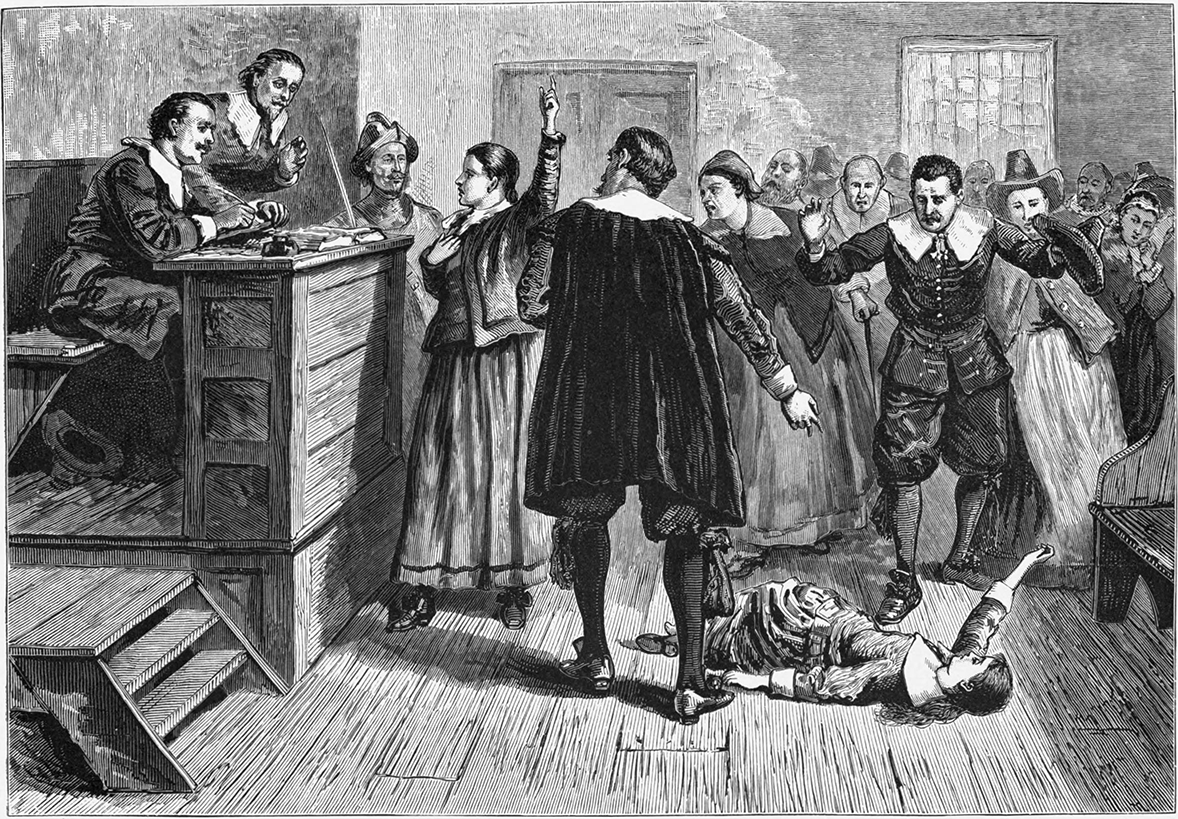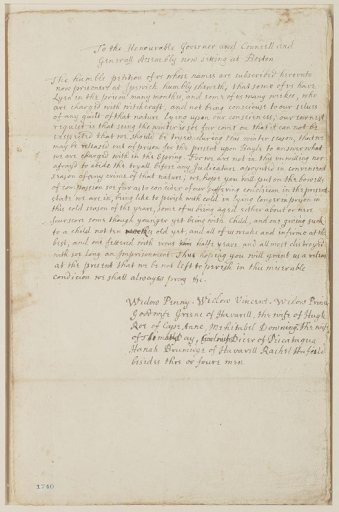Salem Witch Trials: How they began, how they impacted, how they’re never forgotten
In Puritan Salem, Massachusetts, Elizabeth Parris and Abigail Williams, two young girls—perhaps on a lark—unleashed a social pandemic that resulted in public accusations of witchcraft in their village. More than 160 townspeople were accused of practicing the “evil arts” that resulted in the famous Salem Witch Trials. To this day, people still wonder what really went down.

unattributed - William A. Crafts (1876) Pioneers in the settlement of America: from Florida in 1510 to California in 1849[1], Pioneers in the settlement of America: from Florida in 1510 to California in 1849. edition, Boston: Published by Samuel Walker and Company
Witchcraft at Salem Village. Engraving. The central figure in this 1876 illustration of the courtroom is usually identified as Mary Walcott.
Imagine this: You are in the setting of a colonial village in Salem Village, Massachusetts. It's 1692 and there are wooden houses surrounding every section of the village. Pigs and goats are roaming around the village square, while people gather around the courthouse at the head of the village, awaiting the next trial--this one, for the girl who lives next door to you. They are all chanting the word “witch” as she is escorted into the courthouse with shackles around her hands.
That trial you are about to witness would have been part of the hundreds of court hearings that occurred between 1692-1693. These were formally known as the Salem Witch Trials, a series of persecutions of a group of young girls who lived in Salem Village, who were accused of practicing witchcraft, and who claimed to be possessed by the devil. This resulted in a spread of mass hysteria all throughout Massachusetts and a rise of sexist implication towards women who were feared to have more power than the standard Christian rule.
In particular, an 11-year-old girl named Abigail Williams and her sister, Elizabeth Parris, two of the very first people to accuse others of practicing witchcraft in Salem. Abigail lived in the home of her uncle, Rev. Parris, at the time, before she started to notice her and her sister performing odd behaviors in mid-January of 1692.
From crawling up to the top of the chimney, to running around in circles with their arms flying above their heads, both sisters and Rev. Parris knew something “ungodlike'''' was happening inside their very own home. Rev. Parris decided to call in the village doctor, Dr. Griggs, to examine what exactly was happening to Abigail and Elizabeth.

Griggs diagnosed both children as victims of witchcraft, leading to a rise in fear amongst the people of the village. “Who’s next?” “Will I become a victim of witchcraft?”
Evil Accusations: Public Corruption
Salem Village became corrupt after a new eruption of “evil” practices was rumored to have overtaken the community. Accusations made by Abigail and Elizabeth on their bewitchment traced back to Rev. Parris’ servant at the time, Tituba. Tituba usually tended to the children’s needs around the house, and was usually along with them when other adults weren’t around.
Tituba was suspected to be a descendant of a Caribbean tribe before she came to Massachusetts in 1680. Though her job was to serve Rev. Parris and the two sisters, accusations were made against her for practicing voodoo around the children.
Tituba also made “witch cakes” around the children in order to help find the cause of their bewitchment. Unfortunately, her attempt failed and only led her to become a more viable suspect for the causes behind accusations of witchery in Salem Village.

Trial and Confession
On February 29th, 1692, Tituba and two other women, Sarah Good and Sarah Osborne, were accused by the two girls for practicing witchcraft after a series of occasions deemed witchcraft were linked together.
Tituba confessed before the court of practicing witchcraft and declared before the court and people of Salem Village, “The Devil came to me and bid me serve him," a pivotal moment in the start of the trials.
Life was never-after the same in Salem Village. More than 160 people, women and men, were accused of practicing witchcraft in the town. Day-by-day, accusations came out as if it were a free for all. No one could be trusted, not even a four-year-old girl.
The hysteria and witchcraft and dark magic after the trials showcased a more important perspective around the event: a wave of religious extremism resulting from the trials had a lasting effect on townspeople’s attitudes towards church and state relationships. Nothing would ever be the same.
How many died or were killed in the ensuing trials? People consider that, between the accusations made by Abigail and Elizabeth, and the power of the village court and then-current-day law, the level of fear only increased death rates resulting from the witch hunt. Was there a solid way to tell if someone was actually a witch? Were Abigail and Elizabeth one-hundred percent accurate in their accusations of who they thought bewitched them? Did they have ulterior motives--like covering up falsehoods that they made, perhaps in jest, that then got out of hand, and for which they would have been severely punished at home?
The answers remain shrouded in the mist of time.
Let’s confess that this time in history may remain as confusing and disturbing to subsequent generations as it was when it began. But these occult occurrences did serve to make the village famous—or infamous.
Salem Village: Halloween Destination
Now, four centuries later, Salem Village is a destination for all activities and attractions related to the Salem Witch Trials. Every year on Halloween the city sees more than half a million visitors, with reenactments, plays and costumed-actors to remind us of the events that are otherwise masked by history.
And if you can’t get to Salem in person, you might want to read or see Arthur Miller’s powerful play, “The Crucible” to get an idea of the fear that possessed that long-ago society, what it evokes in us today, and why the story is an evergreen reminder that lies, exaggeration and fear can overtake reason anytime, anywhere.
Curious. When or where have you ever experienced anything like that?
Witch Cake Recipe
Old Witch''s Magic Nut Cake
Author: adapted from Wende and Harry Devlin, Old Witch and the Polka Dot Ribbon
Ingredients
- 3 eggs
- 1 15-ounce can pumpkin
- ¾ cup vegetable oil
- ½ cup water
- 2½ cups all-purpose flour
- 2¼ cups sugar
- 1½ tsp baking soda
- 1¼ tsp salt
- ¾ tsp nutmeg
- ¾ tsp cinnamon
- 1 cup golden raisins
- 1 cup chopped walnuts
Directions
- Preheat the oven to 350 degrees F. Lightly oil two loaf pans and set aside.
- Beat together wet ingredients in a bowl. In a second bowl, mix together dry ingredients. Combine the two mixtures, then mix in raisins and nuts.
- Pour batter into loaf pans, and bake for an hour to an hour and fifteen minutes. Cake is done when a toothpick inserted in the center comes out clean.
- Let loaves cool for 15-20 minutes in the pans, then remove and finish cooling on a rack.
- If desired, top with your favorite cream cheese frosting and additional chopped walnuts.
http://www.sprungatlast.com/2014/12/old-witchs-magic-nut-cake/
Want to Learn More?
- Evan Andrews. "7 Bizarre Witch Trial Tests" history.com, 18 Mar, 2014. https://www.history.com/news/7-bizarre-witch-trial-tests. Accessed on 30 Nov, -0001.
- Alyssa Barillari. "Tituba" Salem Witch Trials Documentary Archive and Transcription Project, 30 Nov, 2000. http://salem.lib.virginia.edu/people/tituba.html. Accessed on 30 Nov, -0001.
- Jess Blumberg. "A Brief History of the Salem Witch Trials" smithsonianmag.com, 23 Oct, 2007. https://www.smithsonianmag.com/history/a-brief-history-of-the-salem-witch-trials-175162489/. Accessed on 30 Nov, -0001.
- Ali Martin Scoufield. "History of "Witch" & Implications for Feminism" myacpa.org, 23 Oct, 2014. https://www.myacpa.org/entity/standing-committee-women/blog/history-witch-implications-feminism. Accessed on 30 Nov, -0001.
- Micaela Rene' Cooper. "Mass Hysteria In The Salem Witch Trials" theodysseyonline.com, 12 Jul, 2016. https://www.theodysseyonline.com/mass-hysteria-salem-witch-trials. Accessed on 30 Nov, -0001.
- William DeLong. "Tituba: The Slave Girl Who May Have Used The Salem Witch Trials To Win Her Own Freedom" allthatsinteresting.com, 24 Sep, 2018. https://allthatsinteresting.com/tituba. Accessed on 30 Nov, -0001.
- Morgan Hines. "The perfect place to visit this Halloween: Salem, Massachusetts, is 'Witch City'" USA TODAY, 7 Oct, 2019. https://www.usatoday.com/story/travel/destinations/2019/10/07/salem-witch-trials-halloween-perfect-time-visit-witch-city/3839745002/. Accessed on 30 Nov, -0001.
- Jone Johnson Lewis. "Abigail Williams of the Salem Witch Trials" thoughtco, 27 Feb, 2018. https://www.thoughtco.com/abigail-williams-biography-3530316. Accessed on 30 Nov, -0001.
- Jone Johnson Lewis. "Tituba's Race" thoughtco, 24 Mar, 2019. https://www.thoughtco.com/what-was-titubas-race-3530573. Accessed on 30 Nov, -0001.
- Arthur Miller. "Why I Wrote “The Crucible”" The New Yorker, 14 Oct, 1996. https://www.newyorker.com/magazine/1996/10/21/why-i-wrote-the-crucible. Accessed on 30 Nov, -0001.
- PeoplePill. "William Griggs" PeoplePill, 30 Nov, -0001. https://peoplepill.com/people/william-griggs-1/. Accessed on 30 Nov, -0001.
- Benjamin Ray. "Overview of the Salem Witch Trials" Salem Witch Trials Documentary Archive and Transcription Project, 30 Nov, -0001. http://salem.lib.virginia.edu/overview.html. Accessed on 30 Nov, -0001.
- Ssaha. "The Salem Witch Trials: A case of mass hysteria" vassar.edu, 8 Dec, 2019. http://pages.vassar.edu/realarchaeology/2019/12/08/the-salem-witch-trials-a-case-of-mass-hysteria/. Accessed on 30 Nov, -0001.
- Meredith Worthen. "Remembering the Victims of the Salem Witch Executions" Biography, 21 Sep, 2017. https://www.biography.com/news/salem-witch-trials-facts. Accessed on 30 Nov, -0001.
- "Petition for bail from accused witches, ca. 1692." Library of Congress, 30 Nov, 1691. https://www.loc.gov/resource/mcc.003/?sp=1&r=-0.876,-0.008,2.703,1.682,0. Accessed on 30 Nov, -0001.
- Rebecca Beatrice Brooks. "Abigail Williams: The Mysterious Afflicted Girl" History of Massachusetts Blog, 6 Oct, 2015. https://historyofmassachusetts.org/abigail-williams-salem/. Accessed on 30 Nov, -0001.